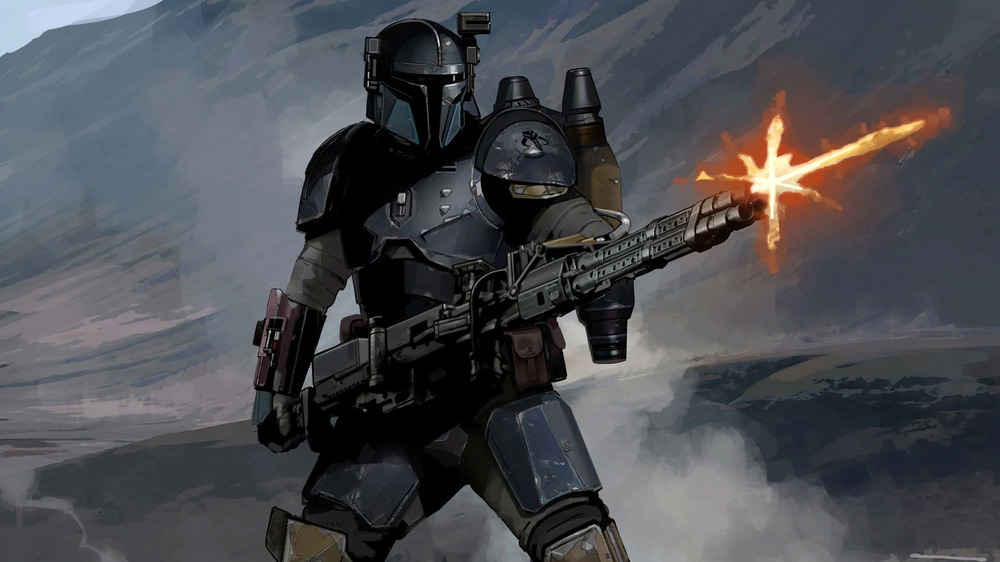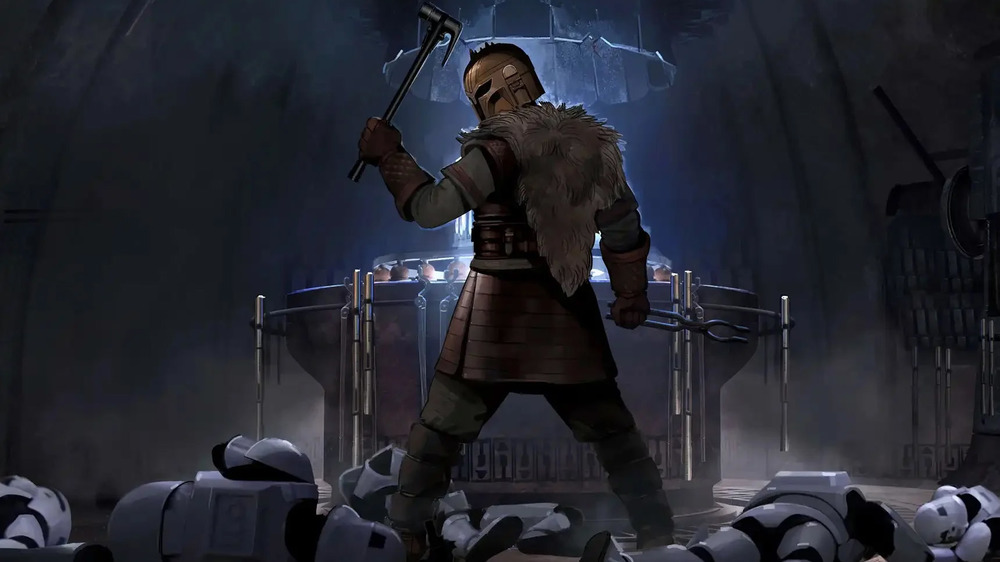The Truth Behind The Mandalorian's Different Types Of Armor - Exclusive
In some ways, The Mandalorian's title is a little misleading. Sure, the adventures of Din Djarin (Pedro Pascal) and his pint-sized sidekick Grogu are the focus of Disney's first-ever live-action Star Wars TV series, but there's more than one Mandalorian in the show — a lot more. There's Katee Sackhoff's Bo-Katan Kryze, former leader of the planet Mandalore. There's her muscle, the enigmatic young Mandalorian known as Koska Reeves, played by WWE superstar Shasha Banks. While Boba Fett's Mandalorian heritage may be murky, he's the one who made their armor famous, and deserves at least honorary status. And then, of course, you have the Children of the Watch, the mysterious Mandalorian cult that made Din one of its own.
That's quite a few characters running around in similar-looking costumes, but the action never gets confusing. Even with their faces covered, you always know exactly which Mandalorian is which. Thanks to The Mandalorian's top-tier design team, every set of armor on the show looks unique, and yet each one remains immediately identifiable as Mandalorian.
It's a delicate balancing act, and exactly how Lucasfilm's art team pulled it off is detailed in Phil Szostak's The Art of Star Wars: The Mandalorian, which walks readers through much of the design work that went into The Mandalorian's first season. That time frame means that season 2 characters like Bo-Katan and Boba Fett aren't covered in the book (although a follow-up volume seems inevitable), but for anyone who wants to see how The Mandalorian forges unique visual identities for its armored characters, it's still a must-read.
According to Szostak, a large element of the show's success when it comes to creating individual looks for its Mandalorian characters is the freedom given to its character designer. "The costume concept artist on our team, Brian Matyas, was fairly free to play with the basic Mandalorian aesthetic established by Boba and Jango Fett, in the films, and The Clone Wars and Star Wars Rebels on TV," Szostak tells Looper in an exclusive interview. "Nothing in particular really unifies them, other than the basic Mandalorian armor shapes."
That doesn't mean that Matyas had free rein, of course. Every Mandalorian design is still informed by the character wearing the armor, which Szostak explains by using the Tribe as an example.
What makes each member of The Mandalorian's Tribe unique
The Tribe, which is part of the larger cult known as the Children of the Watch, features heavily in The Mandalorian's first season. They are a small enclave of Mandalorians who live in the sewers underneath Navarro, and who rise up to help Din and Grogu escape the Empire in the show's third episode, "The Sin." In the season 1 finale, the Mandalorian returned to the Tribe's enclave, only to discover that most of its members were killed while he was off planet.
Members of the Tribe are important characters in The Mandalorian's story, and as such, they received all of the attention that they deserved. "For the Armorer, [Matyas] brought in design elements from ancient Earth cultures, to give her a shamanistic quality, prompted by briefs from the filmmakers," Szostak says. Given the Armorer's position as the head of the Tribe and its resident Beskar-whisperer, that only makes sense.
Din, on the other hand, was designed to play up his professional background. "The Mandalorian himself would have that bare Beskar metal helmet, slimmer than Mandalorian helmets of the past," Szostak explains, "with a hodgepodge of armor pieces reflecting his journey through the galaxy and the enemies he battled as a bounty hunter." As The Art of Star Wars: The Mandalorian shows, Din's costume changes over the course of the series as he collects more ultra-rare Beskar steel and upgrades his outfit.
Finally, Paz Vizsla, the jetpack-using Mandalorian voiced by series creator Jon Favreau, was all about size. "The Heavy Infantry Mando would have bulky and brutalistic geometry to his armor, coupled with art deco and German Expressionist aesthetics, to accentuate his mass," Szostak says.
Comparing these three characters highlights how difficult a task The Mandalorian's art team had, and drives home one of the biggest themes in Szostak's book: Nothing in The Mandalorian is there by accident, or just because it looks cool. Everything is in service of the story and the characters. It's telling its story through design, and as every Mandalorian fan knows, the Lucasfilm crew absolutely nailed it.
The Art of Star Wars: The Mandalorian is on sale now.

